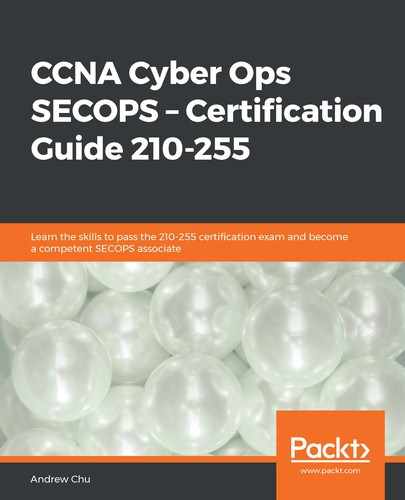- 1. pcregrep.
- 1. SOX.
- 3. It is commonly used by threat actors because it is also used in common legitimate applications.
- 4. Mozilla/5.0 (X11; x86_64; rv:21.0) Gecko/20100101 Firefox/21.0.
- 4. Analysis resulting in conclusive results.
- 2. tcpdump uses UTC time, where Wireshark's packet list pane uses relative timestamps.
- 3. A rule with priority 1 in a policy with priority 4.
- 1. Actors, Actions, Assets, Attributes.
- 1. To determine the format for emails within the organization in order to generate whale phishing targets from the publicly accessible directors list.
- 1. As generic as possible.
- 4. Virtual Alloc.
- 1. At the network layer, the address is maintained from the sending computer to the destination computer.
- 4. User Interaction: Required.
- 3. Confidentiality | Integrity | Availability.
- 3. Exploits are linked to observed vulnerabilities in the system.
- 1. Name of the investigator, and 2. Date of collection.
- 4. Changing the data doesn't affect integrity if the process is documented.
- 3. Year of Birth.
- 4. A flow involving a Tor exit node is identified as a potential threat.
- 2. An internal host is sending large amounts of data out of the network.
- 1. The pipe character (|).
- 4. Confidentiality and availability are both affected, so both should be scored.
- 3. The layer 3 address is hierarchical.
- 4. A European company that has over 300 US shareholders.
- 1. NetFlow would record 2 flows.
- 4. Records to [hacme.com]:80 in NetFlow, where [hacme.com] is the correct IP address for the bank's web server.
- 4. Actor: External | Action: Environmental.
- 3. A copy of the files on a disk.
- 2. DHCP pool depletion caused by excessively long lease time.
- 1. To deter future attacks.
- 2. SSL.
- 4. Systems on the transmission path for card holder data which are on a public infrastructure (for example, the internet).
- 3. The 5-tuple is unchanged throughout the journey from host to host.
- 2. Analysis centers.
- 4. Verification of suspected incident.
- 4. To detect future threat.
- 3. Attributes.
- 2. query user.
- 1. Nothing. The IDS has taken no action, so the file reached its intended target.
- 2. /var/log/messages.
- 4. Command and Control.
- 2. An attacker has persistent access.
- 3. SS[^D].
- 4. Which sources of evidence, if any, should be acquired.
- 3. Actions on objectives.
- 2. Understanding of the context of each entry.
- 3. To identify the appropriate flow.
- 4. NBAR.
- 4. Have all the customer effects from the incident been reset?
- 1. By maintaining a unified time across all the devices in the network.
Chapter 14 – Mock Exam 1
..................Content has been hidden....................
You can't read the all page of ebook, please click here login for view all page.
